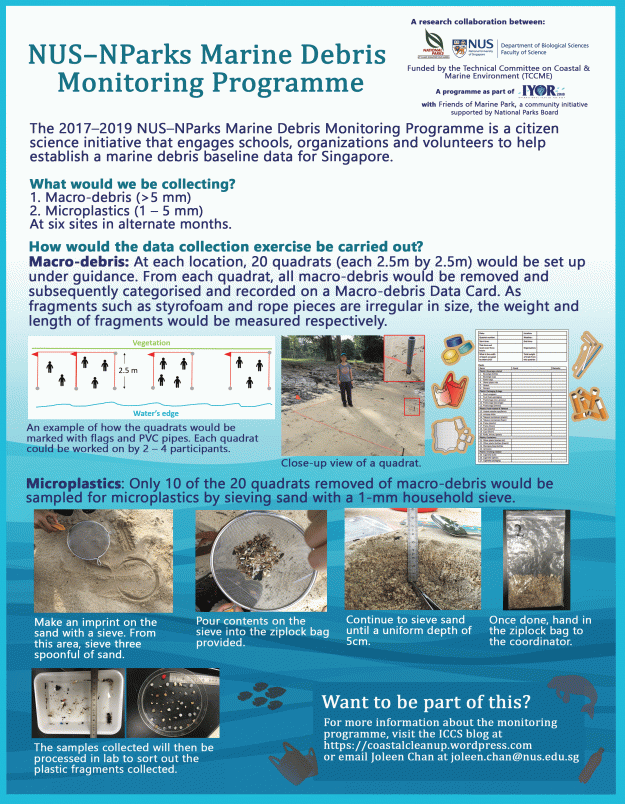Come Participate In The 2017–2019 NUS–NParks Marine Debris Monitoring Programme
Time to Event
The event is over. Thank you for your participation.
The 2017–2019 NUS–NParks Marine Debris Monitoring Programme is a citizen science programme that is initiated in November 2017 to celebrate the International Year of the Reef (IYOR) 2018 as part of Friends of Marine Park.
It engages volunteers, schools, and organizations with an interest to survey and collect data on marine debris found on Singapore’s beaches. Data on both macro-debris (>5 mm) and microplastics (1 – 5 mm) will be collected from 20 quadrats (2.5 m by 2.5 m) at six sites every two months (see map below). These data collected would help form the national baseline of marine debris for Singapore which would help inform decision-making and policy development.
We are looking for passionate and dedicated individuals/schools/organisations who are keen to contribute more than just a cleanup.
For individuals age 15 and above who are interested in participating in the data collection exercises, sign up using this form :(https://goo.gl/forms/a6e6McrFMNU9Huw83) to receive updates of monthly sampling events or register for upcoming events below.
For schools / organisation, sign up using this form :(https://goo.gl/forms/yAxYyPcM14oGhTCn1) for the programme with 20‒40 participants and you will be guided through the data collection exercise. A research sampling kit and cleanup supplies could be loaned as required.
More about the programme
Why research marine debris?
Marine debris is a great cause of concern due to its presence in all our oceans and adverse impact on the marine environment and wildlife. This quantitative sampling will supplement more than 10 years of annual data on marine debris from the International Coastal Cleanup Singapore and provide data on temporal and seasonal variations of macro-debris and microplastics in Singapore.
Why sample from quadrats?
The locations of the 20 quadrats were randomly selected and then fixed to give a better representation of the debris profile of each beach. By returning to the same quadrats each month, we would be able to determine the accumulation rate of marine debris and find out if any temporal trend exists.
Locations of marine debris monitoring programme
Join us in the upcoming sampling events!
No prior experience is required, just your interest!
Briefing and sampling supplies would be provided.
Please click on the respective link below to register.
Please stay tuned for future sampling dates.
Thank you for caring for the environment!
Joleen Chan
Research Assistant
Department of Biological Sciences
National University of Singapore
